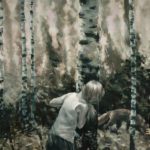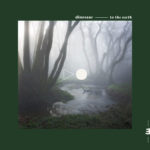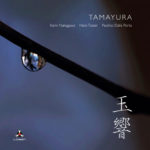While pondering endlessly over my 2020 „top 20“ or „top 30“ or „top 33“ of the year that is drawing to a close, I thought I’ll quickly share a few comments on jazz albums I stumbled upon in 2020, but which no-one has mentioned on this blog at all.
The popularity of RareNoiseRecords (RNR) has noticeably been on the rise here this year, and several contributors to this blog have paid a considerable amount of attention to some of their albums of late. So there is no need that I should add my two cents about Stephan Thelen’s string quartet album or J. Peter Schwalm. I can profess, however, that David Torn’s third album with Sonar left me pretty much untouched – and to my surprise so. One album that, on the contrary, has remained completely under the radar is aptly titled Hiding In Plain Sight and was recorded by a British outfit that I have not (knowingly) heard of before; yet this is apparently already the fifth album by the WorldService Project. RNR classifies the album as „psych-jazz“ and draws comparisons to The Comet Is Coming and Sons of Kemet – which seems to make a lots of sense to me. Interestingly enough, Hiding In Plain Sight is ultimately the better album, – because it is more stimulating and imaginative – compared to what Sonar and David Torn have delivered of late, where one did not hear anything genuinely surprising, sadly enough. Totally different here: A whole lot of distorted instruments – keyboards, sax, bass and percussion (and a trombone added on a few tracks) – as on many RNR albums, there’s banging energy and diverse progressive punk-jazz craziness that may remind one or the other of Django Bates. It comes across somewhat punkier, snottier than Shabaka Hutchings‘ projects, but firstly it’s kind of about Brexit and Europe, and secondly there are also a few softer, more conciliatory pieces in the latter part, so there’s something for everyone in this bag.
During the first half of 2020 I listened to a lot of Edition Records releases, less so during the last few months – I haven’t listened to any of the new releases by the big names on Edition, such as Chris Potter, Tim Garland, Misha Mullov-Abbado or Rob Luft. One album I missed to far, but which I’ll still need to check out is Atlântico by the Portuguese-English-Norwegian trio Mário Laginha (piano), Julian Argüelles (sax) and Helge Andreas Norbakken (drums); I very much loved Setembro, their first album, so I expect their unique blend of ECM-like chamber jazz, Iberian musical poetry and a slight touch of Norway to have matured even more on this new release. I am even more excited about pianist Eyolf Dale’s new album coming out in early 2021 – a new trio with two ingenious „big names“ in the Norwegian jazz scene: drummer Audun Kleive and bassist Per Zanussi. I really like Eyolf; I was lucky enough to join him on tour in the mid-Norwegian coastal region around Molde and Ålesund once, and a year later I was invited to spend a few days filming him recording in the nice studio The Village in Copenhagen, when he was playing in Hayden Powell’s trio. I am sure his new trio project is going to be a great live experience — if the tour will be actually be allowed to take place.
Like quite a few others, Pablo Held released two discs this year; Ascent came out in spring, and Descent a few weeks ago. Funny that no-one on this blog has cared to discuss his inventive jazz albums so far. I find it tricky to find good words for his art, too, but I acknowledge there’s a lot to admire and enjoy. Norwegian tuba master Daniel Herskedal whose amazing work I have been following for at least ten years, has just released a full-on solo album, Call for Winter, which builds on the basic idea of his solo piece The Mistral Noir, a highlight on his excellent Edition album Slow Eastbound Train a few years back. Eyolf Dale played on at least three of Daniel’s albums, by the way.
I listened quite a lot to Kurt Elling’s album Secrets Are The Best Stories. It has just been nominated for Best Jazz Vocal Album at the Grammy Awards 2021. There is something deeply intriguing about his style of singing, and the selection of songs on this album is as fascinating as the band he assembled for the recording – Roman Diáz, Danilo Pérez and Johnathan Blake are among the marvelous players interpreting an alluring selection of songs that include tunes by Jaco Pastorius and Sidsel Endresen. On top of that the album has a fine mystifying and untypical painting on the cover. To be honest I am usually not a big fan of this kind of jazz singing, but this was able to catch my attention. I like this quote from Downbeat: „Elling sings lines that seem impossible. Dystopian dissonance and nightmarish musical images feed dense metaphors wrapped in poetic camouflage. The passion is earnest and pitch perfect.“
Two Edition albums I found very fascinating and which I still feel I have to spend more time with, as there is a lot more to discover, are the latest Dinosaur album, To The Earth, and the mysteriously titled AuB by, well, a band called AuB (supposed to be pronounced „Orb“). The latter includes two British tenor saxophone players who also bring synths into play, Alex Hitchcock and Tom Barford, rounded off with Fergus Ireland (double bass and synths) and James Maddren (drums). Strangely enough, even though this sounds very much like a band effort, and the label website presents AuB as a quartet, the album design pictures only Hitchcock and Barford. However, the rhythm section often comes across quite vigorously and should not be held in low esteem. Funnily, the first track on the album is tiled „Not Jazz“, but no doubt the music on this album is jazz; the synths were woven in very elegantly throughout the whole album, so this is no futurist or retro-futurist fusion stuff, but rather a fine contemporary update of this „classic“ line-up, with a kind of rock-ish punch and live situation feeling. While the album is not exactly outstanding, it is enjoyable and catchy, and I quite like how the band keeps it clear at all times, never just drifting off into anything, which to me seems to be a noticeable pitfall here.
The Dinosaur album, meanwhile, is even better and surpasses their widely praised 2016 debut album (I don’t think I’ve heard the second one, Wonder Trail, which came out in 2018, but trumpeter Laura Jurd’s separate ensemble project Stepping Back, Jumping In, released in 2019, was truly dazzling) and I’d love to hear them live sometime. I can only imagine that they must be terrific. Pianist Elliot Galvin is the only one using synths here, so the whole project has become pretty much an elegantly acoustic affair after the more electric predecessors. The concise 41-minute album is also very versatile, with engaging rhythms and captivating melodies and performances by all four members; featuring almost exclusively tracks penned by Laura Jurd, To The Earth sounds almost like a timeless classic, taking the influences and energies of acoustic jazz quartets from the fifties and sixties and making them feel very much alive in 2020. Speaking about the album, Laura says:
“My discography to date, as Dinosaur and albums under my name, is the result of an unavoidable necessity to express and share a wealth of musical interests – from folk influenced counterpoint, to song-writing, Stravinsky-inspired harmony to the use of analog synthesis and looped grooves. Whilst this may well dizzy the narrative surrounding my output, jazz (in its most typical form) has always played a huge role in my life and the life of this band. ‚To The Earth‘ is simply a collection of joyfully crafted melodies, which we can dive into and explore as improvisers. It makes so much sense that this is the music to surface after a decade of playing together“.
Dinosaur keyboardist and pianist Elliot Galvin has also released his first solo piano album on Edition in 2020, and like quite a few albums by the on this blog very popular Keith Jarrett, it was recorded live in concert and improvised entirely on the spot. The eponymously titled Live In Paris At Fondation Louis Vuitton presents the multifaceted young pianist as an ardent student of Jarrett and Craig Taborn, but with his rather unique voice: „This concert was created completely in the moment, nothing was pre-prepared or pre-planned. I was responding to that moment in time, to that audience, in that space. You have to be willing to share your complete soul with an audience, trusting them and yourself totally, making the deepest most human connection you possibly can. This record is a document of that moment we all shared. Strangers unified by sound“. Personally, I often find it a little hard to appreciate such freely improvised piano albums adequately, but I am confident that the admirers of Jarrett and piano solo productions with a penchant for classical chamber music will find a lot to like with Galvin’s playing.
Last but not least, a truly fabulous jazz marvel, designed to be the first of a four-part series on the theme of humankind and our planet and future, and released earlier this year, was Jasper Høiby’s Planet B with bass and electronics, saxophone (Josh Arcoleo) and drums (Marc Michel). It’s downright unjust that this LP has received so little attention. I bought the beautiful LP in eco-green vinyl out of respect for Høiby’s achievement alone. Stefan Vinaricky praised the work on Nordische Musik:
„How is jazz influenced by social and political issues, and how can jazz musicians use their art to enrich this discourse? These are questions that have become gradually less significant in recent years and decades. Long gone are the days when John Coltrane’s „A Love Supreme“ was something like the soundtrack to Martin Luther King’s „I Have a Dream“ speech; without mentioning the fact that the very emergence of jazz as such is already highly imbued with socio-political connotations. Danish bassist Jasper Høiby tackles this depoliticization of jazz and, on „Planet B,“ raises big questions of our time, including ecology or climate protection, sustainability and social justice. He does this by placing speech excerpts given by cultural philosophers, professors of psychology and civil rights activists as speech samples under his music.
These might be annoying for one or the other who simply wants to listen to music, and indeed one might argue whether or not Høiby thereby lives up to the undoubtedly pressing concerns. But he is quite clever in his use of samples: The pieces with larger sections of speech are kept rather simple in terms of composition, and the resulting musical flow gives the speeches an almost soundtrack-like character. In addition, he repeatedly reaches for his bow and effects devices when playing the bass and by layering the sound he creates a dense sonic tapestry that supports the vocal elements. In the purely instrumental pieces, on the other hand, he proceeds much more vigorously with his fellow international comrades-in-arms (…) and presents us with a sometimes quite free trio jazz, without the album falling apart into two disparate parts.“
Edition released 19 or 20 albums this year, and I just have to add that I don’t like many of their recent cover design decisions. Some of them have a kind of tediousness (at times even a cheap feel) that doesn’t really feel inspiring to pick up and buy the albums. Which is a bit sad, because the label has evolved into an essential force in the European jazz scene. The photos are often great (see To The Earth), but the designs, the choice of graphical elements, fonts, and letters don’t exactly work towards their advantage. Similarly, with Herskedal’s latest album, they have decided to break with the fabulously coherent series of his beautiful covers, and graphically deform the photo on his latest album. The same thing with the cover of Høiby’s Planet B: Basically a gorgeous photo, but the oversized letters and the garish colorful framing are rather disruptive and unnecessary. On the inside cover you can find the picture again with a white frame, and that makes it so much stronger and more appropriate than the over-designed front cover.
Another label I have followed closely for many years is Losen Records, operated out of Oslo by Odd Gjelsnes, but by no means does he solely focus on Norwegian projects; he maintains close bonds with the Barxeta studio near Valencia („music studio situated on the top of a hill in the middle of a gigantic orange plantation“) and has a long history of keenly exploring many other parts of the world, releasing between 20 and 40 albums a year.
A few years ago, he issued the second album by the trio Anders Jormin, Karin Nakagawa and Lena Willemark, whose dreamlike avant-traditional debut, Trees Of Light, had been released by ECM. Now the Japanese singer with her 25-string koto, who lives halfway between Bavarian towns Landshut and Passau, scored a magical album of her own on Losen Records: Tamayura features soprano saxophonist Hans Tutzer and Oregon bassist Paolino Dalla Porta; Marco Ambrosini guests on nyckelharpa. Karin Nakagawa’s nicely designed and enchantingly written and performed album draws geographical as well as spiritual lines between (Northern) European and Japanese folk music, between jazz and chamber music, past and present. A truly lyrical and poetically enriching album for winter 2020 and for contemplation – and very much in line with the above mentioned albums by Anders Jormin and Marco Ambrosini et al. It’s really one of my favourite records of the many dozens of Losen albums I was invited to listen to, and I certainly hope this imaginative artist will find a bigger audience – among ECM fans for example. The album title, by the way, is a poetic Japanese way to describe a short, fading moment, as of the explanation on the cover: „treasure of resonance in a fully experienced, yet impermanent moment“.





